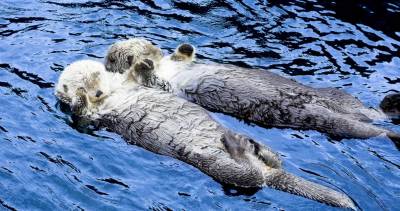Old Trout Puppet Workshop invents a wild, imaginary world in Jabberwocky
Created by the Old Trout Puppet Workshop and Friends. An Old Trout Puppet Workshop production, presented by the Cultch. At the York Theatre on February 7. Continues until February 17
Jabberwocky explores the primal, eternal recurrences in life’s journey: the urge to mate, the call to adventure, the inevitable disappointment, and the passing of the torch. Because it deals in archetypes, the story is simple—but its presentation is anything but.
The performers, from Calgary’s Old Trout Puppet Workshop, begin by trading off lines—sans puppets!—in a dramatic recitation of Lewis Carroll’s famous nonsense poem, from Through the Looking-Glass, and What Alice Found There, savouring the delicious absurdity of made-up words like vorpal and galumphing. This is followed by a sequence that illustrates natural cycles—flowers, bees, plants, animals, digestion, reproduction—using a dizzying array of techniques: lights, two-dimensional puppets, and scrolling backgrounds. This sequence is full of surprises: in one memorable image, a human performer dressed in white represents the mother’s milk making its way from her nipple to the mouth of a hungry baby.
The story then settles in on one family. Father, mother, and son wear headpieces resembling the March Hare from the Alice book’s celebrated illustrations. When the father returns, disappointed, from his own attempt to kill the Jabberwocky (or slay the proverbial dragon), the son steals his “vorpal sword” and heads out on his own adventure.
Characters and imagery from Carroll’s books make occasional cameos, but most of the world is invented. As the son heads out, the backdrop changes from a bucolic landscape to a gritty urban setting, the horizon obliterated by skyscrapers. In one of the show’s most immersive sequences, our hero gets a job alongside two-dimensional rabbits in business attire, repeatedly rubber-stamping documents to a rhythmically complex soundscape. (There’s no composer credit in the program for the sinewy music, but throughout the show, Jonathan Lewis’s sound design contributes as much to the adventure as the visuals.)
In the "Jabberwocky" poem, the Trouts have found not only a new way to dress up their favourite themes (birth, death), but inspiration for the work’s underlying mechanics. Scrolling panoramas are a Victorian-era theatre technology; scenic painters Katie Green, Pityu Kenderes, Dawna Mark, and Chelsea Teller display their loving attention to detail in everything from rich red theatre curtains to striped-wallpaper domestic backdrops and dark, earthy skyscrapers.
Performers Nicolas Di Gaetano, Teddy Ivanova, Kenderes, and Sebastian Kroon work their butts off handling the show’s countless moving parts. There’s a wonderfully inventive scene of the son watching his parents fool around: as the boy crouches upstage outside their door, the parents chase each other while another performer holds up a cutout of a keyhole in front of them. It’s a bit like live cubism: we assemble the layers into the whole.
Familiar story? For sure. But the presentation gives it a fresh, wholly original spin.















Comments